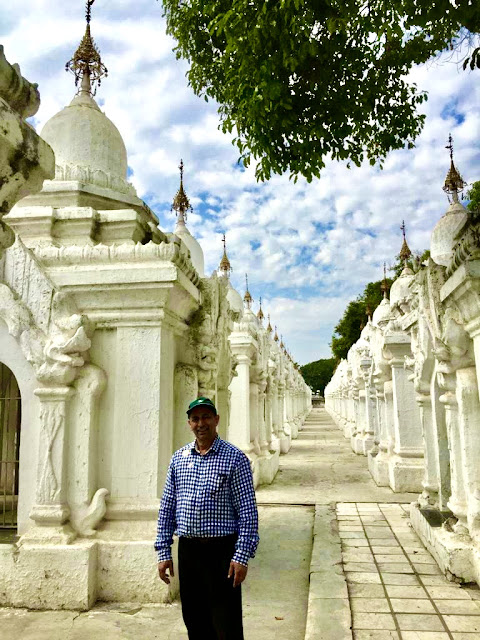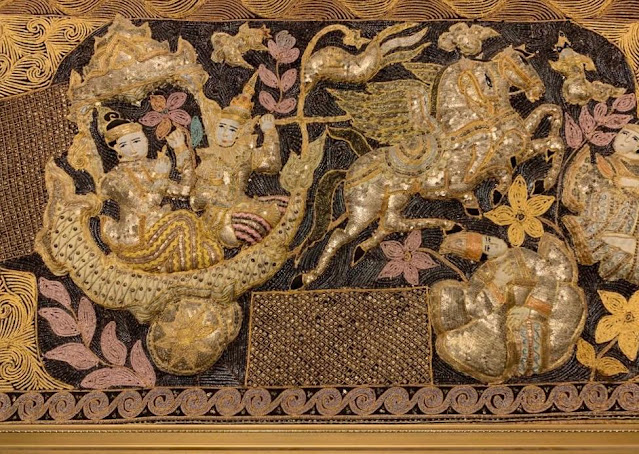Come, You Back To Mandalay, Burma
Blog number 6. 31.10.2020. nguptatravelscrapbook.blogspot.com
Current COVID-19 Status in the UK. More and more cities are coming under Tier 3 ( High risk) of the second Lockdown.
Come, you back to Mandalay, Burma
Road To Mandalay
By the old Moulmein Pagoda, lookin' lazy at sea,
There's a Burma girl a-setting', and I know she thinks o' me;
For the wind is in the palm-trees, and the temple-bells they say:
"Come you back, you British soldier; come you back to Mandalay!"
Come, you back to Mandalay.
Opening verses of the Poem Mandalay by Rudyard Kipling
Rudyard Kipling, a late -Victorian novelist, the Noble Laureate (1907), wrote the glorious poem Mandalay (published in 1890) set in colonial Burma. He never visited Mandalay (visited other parts of Burma), but that did not stop him from composing the famous poem which reflected his romance and yearnings for Mandalay. It was the capital of The Province of British Burma (a part of British Colonial India from1886 to 1937) and a separate British Colony from then on leading to its independence in 1948.
To us, it sounded as if Mandalay and Kipling were interchangeable lingoes. One would come across Kipling's inscriptions everywhere in the city along with the same in the names of hotels, restaurants, cafes, cinemas and many such more. In my living imagination, Mandalay's phrase kindles through the virtue of several other destinations visited by me. Saigon, Shanghai, Leningrad, Bukhara, Silk road, Mombasa, Bombay and Calcutta came to my senses quickly.
We took a short 30 minutes morning flight from Bagan, northwards to Mandalay to start our sightseeing tour early since the itinerary was jam-packed. They arranged the local travel services to take our suitcases to the hotel Sedona. An actual-time saved!
Miracles of Mandalay
Mandalay is a contemporary and modern-day town but hides strong and heritage impressions in its trails and alleyways. The leaflets about the famous sights in Mandalay and around (Amarapura and Mingon) are full of added superlatives illustrating their Magnum opus.
I have set these sights in the bullet form here and would briefly narrate them.
• The most unshapely Buddha (Mahamuni Temple)
• The world's biggest book (In Kuthodaw Pagoda)
• The longest Wooden Bridge (U Bein Foot Bridge in Amarapura)
• The largest Bell (In Mingon)
• The colossal Royal Citadel, Mandalay (The Glass House by Novelist Amitav Ghosh)
Mahamuni Temple (meaning the Great Sage)
We started our day trip by visiting Mahamuni Temple based just south of the principal town.
It was a lifetime occasion for both of us to worship in the grounds of this temple, the highly venerated pilgrimage site in Burma. Here the Buddha image is thoroughly glazed with gold leaves donated as offerings to Lord Buddha deity, causing a slightly disfigured image of Buddha which remains lovingly lustrous though! I posted the picture of the temple at the start of the blog, below is a picture of another time where my husband performed a similar ritual of offering a gold leaf to a Buddha divinity. They do not allow women to enter the inner-most sanctum of these temples.
Kuthodaw Pagoda
At the foothills of Mandalay Hill, the grounds of Kuthodaw temple contain 729 Stone inscription caves, each containing a marble slab with inscriptions of Tripitaka, Teachings of Buddha.
Shwenandaw Teak Monastery
Famous for its teak carvings, a surviving central structure of the original Royal palace, disassembled from its place in Mandalay and overhauled at this location.
U Bein Foot Bridge
Late afternoon, we arrived at the U Bein Foot Bridge in Amarapura, about 10 KM south of Mandalay. They call it the world's longest teak bridge, nearly 200 years old, spanning nearly 1.2 Km across the Lake Taungthaman and used by daily commuters. The entire area surged with vendors, daily travellers, many tea and food stalls and souvenir shops. It was a dream click to capture monks trailing on the bridge or otherwise in their bright saffron robes while taking snapshots of the sunset from a gondola in the lake. On return to the hotel, they served us a delicious dinner alongside freshly baked French baguette, a mouthwatering treat!
The following day we visited.
• Mandalay Hill and its Pagodas
• A cruise on Ayeyarwady river to see Mingon bell.
• The Royal Citadel (The Glass Palace)
Mandalay hill and Its Pagodas
Arriving at the top of the hill entails approximately 1700 steps. Well, none of us had a fondness for this experience and hence safely took the lifts to reach the top. One encounters the expanded and sweeping views of the city from atop which itself is studded with multiple pagodas.
The Mingun Bell and Road To Mandalay
The Ayeyarwady River, flowing across the country from north to south, is the primary commercial waterways of the country being referred by Kipling as The Road To Mandalay in his poems. They arranged us for the river cruise to Mingun (about 10 KM) giving superb panoramic views of life on the banks of the river followed by a visit to see the Mingun bell nearby.
This bell weighs nearly 90 tonnes, the words largest bell, with inferior sonics because of impaired resonance.
The Royal Citadel
The Royal Citadel, a Great Burmese pride, was once regarded as Asia's last grand wooden palace complex, a citadel covering an area of 2 sq kilometres and surrounded by a moat. Amitav Ghosh (Nominated for Booker Prize for The Glass Palace) has famously described it in his book. I found the present set up of the royal palace de facto conforming with my vision of it communicated from his book. Allied bombings in 1945 demolished the complete structure. A significant reconstruction builds the palace at the same sight using modern building materials, but nothing is in common to the original monument.
The Royal Citadel
A word about famous Burmese art called Kalagas.
When visiting Bangkok in 1992, I came across Kalaga tapestries imported over from Burma, being sold on the roadside by Thai vendors. I learnt that Kalaga is a traditional name for hand-embroidered tapestries produced in Mandalay region of Burma. The artisans use sequins, beads, multicoloured stones, pearls, corals, gold and silver threads etc. with base material of cotton, linen, velvet or silk. They fill up the key figures in the tapestry with flannel or fine fibres to give a 3 D effect. They relate the most common theme of these tapestries to Hindu epics of Ramayana, Mahabharata and the life of Buddha. I have posted here two pictures of such masterpieces bought in Bangkok and now on the walls in my home. During this trip, I tried to source such tapestries but unfortunately could not find any. Is it a dying art now?
Kalaga illustrating the famous Geeta Updesh/Saar Piece from The Epic Mahabharata
Today, as I prepare my blog for publishing, the genuine prospects of a second complete lockdown are dominating over here in the UK. There is no Halloween hustle and bustle while restraining children and grandchildren indoors. A regulation is in place for them not to take part in the guising (going door to door) for famous trick or treat activities! But the spirit of Halloween prevails indoors.
I wish Happy Halloween to all my readers. Stay well, and stay safe!
I would write the remaining part of my journey in Burma, including Inle lake adventures travelling via a visit to Pindaya caves, in the upcoming blog next week.


















Beautiful and comprehensive blog as before. Happy Halloween.
ReplyDeleteHappy Halloween to you all.
DeleteLovely description. The foot bridge is interesting and the pictures are unbeatable.
ReplyDeleteThank you, Praveen. Most welcomed comments.
DeleteThat bell is amazing!! Would love to hear it ring sometime!
ReplyDeleteComprehensive read .. gives an insight into Myanmar’s culture .
ReplyDeleteThank you Mamta.
DeleteI have seen these framed painting adoring the walls of your beautiful interiors but have learnt about their heritage value now only. You have always been curious to know about historical aspects and it most aptly is reflected in your writings here. Significant pics to deliver what has been the theme of your writings !
ReplyDeleteThank you Dr Malti.
DeleteBeen to Yangon last year. Haven’t traveled like you both. Beautiful Myanmar always give beautiful memories. Your writings about your travels are exemplary, enjoy reading them. Get the feeling that we were there then. Thanks
ReplyDeleteVallakurichi is our family originated place in south india, always included as my father’s surname. Barathan
ReplyDeleteThank you, Vallakurichi. Yes, my daughter Dr Ruchika Gupta is married to Dr Vijay Barathan.
Delete